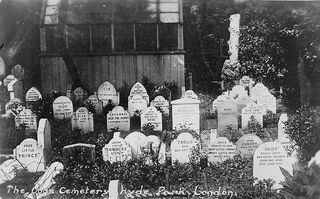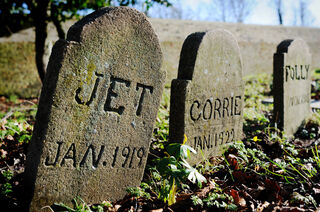Relationships
More Dogs Going to Heaven Than Ever Before
A new study of pet cemeteries reveals shifts in human-animal relationships.
Posted October 29, 2020
Stephen King has established the pet cemetery (or ‘semetary’) in our collective imagination as a spooky place befitting of Halloween. But I don’t find pet cemeteries the least bit scary. To my mind, they offer a beautiful testament to the human-animal bond and the power of loss and mourning. They are also a goldmine for scholars studying human-animal relationships.

A recent example of “pet cemetery studies” is a study by historical archaeologist Eric Tourigny published in the journal Antiquity. Tourigny uses the pet cemetery to explore shifting patterns of human-animal relationship through the lens of mourning practices. Specifically, Tourigny uses gravestone markers at British cemeteries to delve into shifts in the way people think about animals and the afterlife from the Victorian period to the present (roughly from 1890 to 1980). These memorials, he writes, suggest that people struggle to define their relationships with pets and that feelings of love and attachment are often in tension with culturally accepted practices. Are deceased animals just pets, however beloved? Or are they family? Increasingly, he says, animals were viewed as something more than just pets, but something less than full-fledged members of the family. His findings also indicate increasing acceptance of the belief that animals have souls and that they go to heaven, where they will be reunited with their human loved ones.
Tourigny looked at gravestones in four cemeteries in the UK, looking for shifts in how graves are marked (e.g., with headstone and footstone) and what is engraved on the markers. The vocabulary used on gravestones, he says, is typically quite simple: it includes the name of the animal and perhaps the date of death and sometimes a few details about the relationship: loyal friend or beloved pet. Many include the name of the person erecting the memorial, although by mid-century proper nouns are often replaced with pronouns such as ‘Mummy,’ ‘Dad,’ or ‘Nan.’ References to animals as family members increase after the Second World War and pet gravestones begin to feature the family surname. Sometimes the surnames are put into quotation marks, “as if to acknowledge they are not full members of the family” (p. 6). This, alongside the practice of having separate cemeteries for humans and pets, emphasizes “how people struggled to identify and label their relationships.” (p. 7) Animals are both family and not-family. (See my post Are Pets Really Family?)
In addition to showing increased references to animals as family, Tourigny’s analysis also indicates an increasing openness to the idea that animals have a soul and that human and animal companions may be reunited in the afterlife. Some gravestones reference Biblical scriptures that might be interpreted as suggesting that a deceased animal has a soul. For example, several feature Luke 12:6 (‘Not one of them is forgotten before God’) or Psalms 50:10 (‘Every beast in the forest is mine, saith the Lord’). Christian symbolism also becomes more prominent on animal gravestones toward the middle of the twentieth century.

The creation of cemeteries dedicated to the burial of pets in itself is evidence of shifting attitudes and tensions between conflicting cultural threads. For example, an increasing desire for public expressions of grief following the loss of a companion animal pulled against the disapproval of open grieving for “mere animals.” Pet cemeteries were separate from human cemeteries; deceased animals could be buried and marked but could not be buried on consecrated ground. Animals were not treated the same as humans.
One additional finding that I find quite interesting is that most gravestones in Tourigny’s study period were for dogs. As we progress through the 20th century, though, an increasing proportion of cats are represented. Cats, it seems, were finally getting their due.
“Pet cemetery studies” can take us well beyond Tourigny’s research focus of 1890-1980 Britain and into the 21st century. In the past several decades, more and more human cemeteries in the UK, US, and elsewhere are welcoming animals and allowing humans to rest in peace alongside their animal companions. Gravestones are more likely to describe a deceased animal as really, truly part of the family, without the scare quotes and hedging. There has been growing attention to natural or “green” burial options for animals as well as people. And the number of people choosing cremation—including the environmentally-friendly option of water-based cremation—instead of burial has increased.
Perhaps the most important shift, and one that I have not seen addressed in the research literature, is the increasing secularization and popularization of overtly religious language and imagery in the realm of pet loss and bereavement. Veterinarians as well as pet owners—including those with no religious affiliation--will often refer to “heaven” (e.g., Home to Heaven In-Home Euthanasia service; “Fluffy is in heaven now,” “Kitty has gone to a better place.”) and angel wings (e.g., a euthanasia vet may say, at the moment of an animal’s death, “Bingo has his wings”). The popular Rainbow Bridge imagery also explicitly refers to animals entering heaven—although animals have to wait patiently on the “wrong” side of the bridge until their human owner dies and they can be reunited and cross to heaven together. (I wrote about animal heaven a few years ago.)
Pet cemeteries are fascinating expressions of how we humans react to the death of our animal companions and are rich resources for scholarly study and individual reflection. What I would really like to know, this Halloween, is whether dogs and cats become ghosts.
References
Eric Tourigny. “Do all dogs go to heaven? Tracking human-animal relationships through the archaeological survey of pet cemeteries,” Antiquity 2020. https://doi.org/10.15184/aqy.2020.191.


